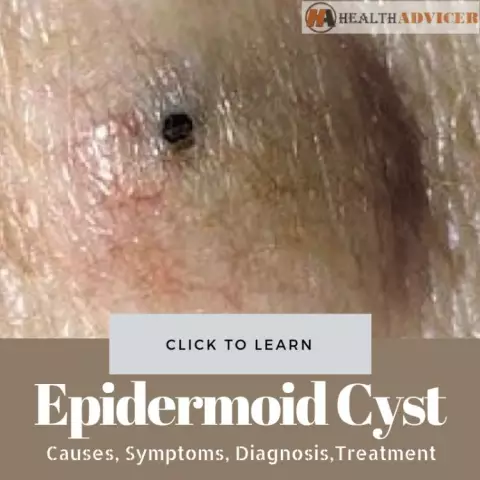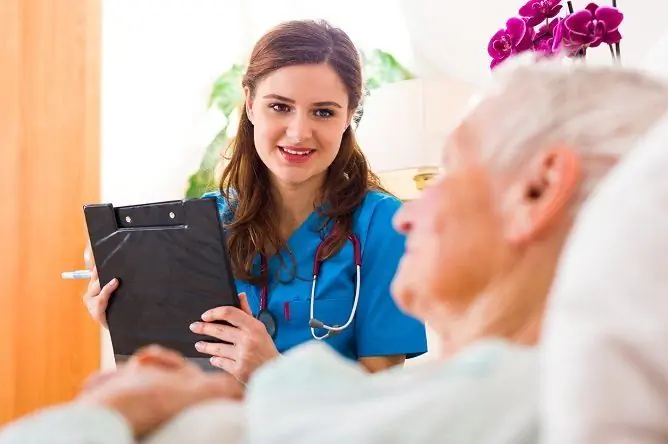- Author Rachel Wainwright [email protected].
- Public 2023-12-15 07:39.
- Last modified 2025-11-02 20:14.
Stroke
Brief description of the disease

Literally translated from Latin, the word "stroke" means "jump" or "jump". In principle, our ancestors very accurately determined the essence of this insidious disease, because a cerebral stroke is characterized by a sudden disappearance or significant impairment of cerebral functions, as a rule, leading to the death of a person within 24-48 hours. Note that the stroke itself is a one-time event, but it is preceded by a rather long process of functional changes and irreversible brain damage.
Stroke types
Depending on how the stroke manifests itself, the symptoms of the disease are divided into several types and form the main classification of the disease:
- ischemic stroke - accounts for 80% of all registered cases, is associated with acute disturbances in blood supply to certain areas of the brain;
- hemorrhagic stroke - signs of the disease appear when various parts of the brain are soaked in blood or with an intracerebral hematoma;
- subarachnoid hemorrhages - occur when the blood vessels of the meninges rupture;
- in about 5% of cases, the cause of stroke remains unclear.
Timely diagnosis of pathological changes in the human brain is essential for the early detection of serious problems and the prevention of strokes of all types. For this reason, modern equipment is being introduced in all clinics around the world, which makes it possible to detect an approaching "explosion" in time and take measures before, and not after a stroke. One of the most effective and well-established diagnostic technologies is computed tomography.
Stroke - symptoms and clinical picture
In the vast majority of cases, the disease begins suddenly, develops very quickly and often leads to death of a person or irreversible brain damage. An attack can last as long as a few minutes or 1-2 days, but in either case, a person's life is endangered due to the rapid death of brain tissue. For a stroke survivor, rehabilitation is an integral part of treatment because it stops the expansion of the affected area and leads to a significant improvement in the quality of life. Nevertheless, we are forced to note once again that both ischemic and hemorrhagic strokes cause irreversible damage to the meninges, that is, anyone should know about what signs can determine the approach of an attack and how to act in case of a sudden, spasmodic development of the disease.
The symptoms of a stroke depend on which part of the brain is being changed. As a rule, a person feels in advance a slight depression of consciousness and depression. Also, patients are unable to control their emotions, are easily aroused and take a long time to restore mental balance. Directly during an attack, the following symptoms are clearly manifested:
- hemorrhagic stroke - sharp, "dagger" pain in the head, loss of consciousness, convulsions, drowsiness, lethargy, frequent nausea and vomiting;
- ischemic stroke - signs of indistinct, growing gradually. This form of the disease is characterized by headaches, hoarse breathing, discoloration of the skin, repeated vomiting and loss of consciousness in later stages. After a stroke, paralysis and paresis, stiff neck muscles, meningeal syndrome, and dementia are often observed.
In principle, immediately at the time of an attack, it is not a problem to determine a stroke, since paralysis of the limbs, breathing difficulties, speech and consciousness disorders manifest themselves simultaneously, and this greatly simplifies the diagnosis. It is a different matter if the patient develops a so-called transient cerebral stroke. In this case, the doctor of the arriving ambulance can see a completely healthy person in front of him and form a false picture of the events that have occurred, despite the fact that a few minutes before his arrival the patient could not speak and did not feel his limbs. Accordingly, in case of any symptoms of brain damage, the actions of the medical staff should be reduced to one thing - urgent hospitalization of the patient.
First aid after a stroke

The first thing you should do if you suspect a stroke is to call an ambulance. Relatives of many patients lose time, tossing about the apartment uselessly while precious minutes leave, allowing to save a person's life. Don't repeat common mistakes. When a stroke is diagnosed, the patient's treatment should be carried out only by professionals in specially equipped clinics, and it is the first hours of the development of the disease that are extremely important, when there is a chance to stop the death of brain tissue in time.
Self-medication for a stroke is pointless and, moreover, extremely dangerous, but, nevertheless, before the ambulance arrives, you can take a number of actions to improve the patient's condition:
- lay the victim on high pillows so that the head is raised above the bed level by about 30 cm;
- ensure the flow of fresh air into the room;
- free the patient's neck, unbutton the tight shirt collar and get rid of embarrassing clothing;
- if a person has a stroke, the symptoms of which are expressed in high blood pressure, give the patient a drug that lowers blood pressure;
- when vomiting, turn the patient's head to one side to prevent vomit from entering the respiratory tract. Cleanse your mouth thoroughly after each vomiting attack.
This is probably all that you can do at home. All other activities are under the jurisdiction of doctors, who must prescribe the necessary diagnostic procedures to the patient and decide on the expediency of surgical intervention. The latter is often used after a stroke caused by stenosis (narrowing) of the carotid artery. If it limits the flow of blood to the brain, the surgeon makes an incision in the neck, removes the dangerous plaque, and sutures the carotid artery. Such operations have long been worked out, but this does not make them less dangerous, since after they are carried out, serious complications are possible. In addition, surgical intervention is contraindicated for many patients due to concomitant cardiac pathologies and a number of other diseases.
Rehabilitation after a stroke
The beneficial effects of spa treatments, which significantly reduce the risk of recurrent strokes, were noticed as early as the 19th century. Rehabilitation measures for people who have suffered a stroke are based on: sea bathing, mud therapy, mineral waters and a suitable (preferably mountainous) climate. In this case, treatment is prescribed only 4-6 months after a person has had a hemorrhagic or ischemic stroke, since doctors need to assess the consequences of an attack and prescribe procedures depending on the patient's condition.
If the patient has serious complications after a stroke, rehabilitation is contraindicated for him. These complications include: severe motor and speech disorders, mental changes, dysfunction of the pelvic organs, the inability of a person to self-service, epilepsy, severe arrhythmias, aortic aneurysm and severe circulatory failure.
When choosing a resort, you should be guided by the doctor's recommendations, taking into account the patient's condition, autonomic regulation disorders, meteorological dependence and other important factors.
Before the trip, it is advisable to undergo a comprehensive examination of the body so that possible health problems do not spoil your and your loved ones' therapeutic rest in the bosom of nature.
YouTube video related to the article:
The information is generalized and provided for informational purposes only. At the first sign of illness, see your doctor. Self-medication is hazardous to health!






